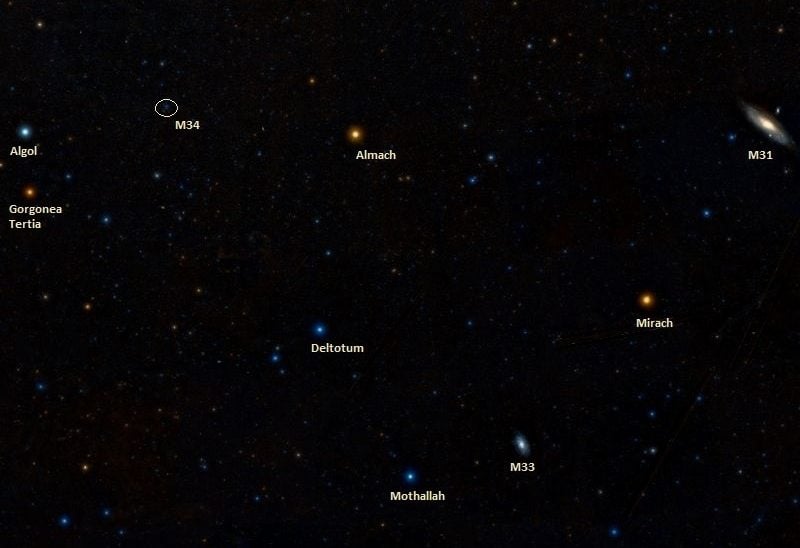Welcome back to Messier Monday! In our ongoing tribute to the great Tammy Plotner, we take a look at the Triangulum Galaxy, also known as Messier 33. Enjoy!
During the 18th century, famed French astronomer
Charles Messier
noted the presence of several "nebulous objects" in the night sky. Having originally mistaken them for comets, he began compiling a list of them so that others would not make the same mistake he did. In time, this list (known as the
Messier Catalog
) would come to include 100 of the most fabulous objects in the night sky.
One of these objects is known as Messier 34, an open star cluster located in the northern
Perseus constellation
. Located at a distance of about 1,500 light years from Earth, it is one of the closest Messier objects to Earth, and is home to an estimated 400 stars. It is also bright enough to be seen with the naked eye or binoculars, where light conditions permit.
What You Are Looking At:
This cluster of stars started its journey off together through our galaxy some 180 million years ago as part of the "Local Association"... groups of stars like the Pleiades, Alpha Persei Cluster and the Delta Lyrae Cluster that share a common origin, but have become gravitationally unbound and are still moving together through space. We know the stars are related by their common movement and ages, but what else do we know about them?
[caption id="attachment_133253" align="aligncenter" width="580"]
The core region of the Messier 34 open star cluster. Credit: Wikisky
[/caption]
Well, one thing we do know is that out of the 354 stars in the region survey, 89 of them are actual cluster members and that all six of the visual binaries and three of the four known Ap stars are members of the cluster. There's even a giant among them! But like almost all stars out there, we know they usually aren't singles and actually have companions. As Theodore Simon wrote in his
2000 study
regarding NGC 1039 and NGC 3532:
If there's companion stars to be discovered, what else might be in the field that we just can quite "see"? Try white dwarfs. As Kate Rubin (et al.) published in the
May 2008
issue of the Astronomical Journal:
[caption id="attachment_34028" align="aligncenter" width="580"] [/caption]
While it sounds a little confusing, it's all about how star clusters evolve. As David Soderblom wrote in a
2001 study
:
History of Observation:
M34 was probably first found by Giovanni Batista Hodierna before 1654, and independently rediscovered by Charles Messier in on August 25, 1764. As he described it in his notes:
[caption id="attachment_133257" align="aligncenter" width="580"]
Image of Messier 34 taken by the Two Micron All-Sky Survey (2MASS) of Messier 34 (also known as M34 or NGC 1039). Credit: 2MASS/UMass/IPAC-Caltech/NASA/NSF
[/caption]
Over the years, a great many historic observers would turn a telescope its way to examine it - also looking for more. Said Sir William Herschel: "A cluster of stars; with 120, I think it is accompanied with mottled light, like stars at a distance." Yet very little more can be seen except for the fact that most of the stars seem to be arranged in pairs - the most notable being optical double in the center - h 1123 - which was cataloged by Sir John Herschel on December 23rd, 1831.
Charles Messier discovered it independently on August 25th, 1764, and included it in the Messier Catalog. As he wrote in the first edition of the catalog:
But as always, it was Admiral William Henry Smyth who described the object with the most florid prose. As he wrote in his notes when observing the cluster in October 1837, he noted the following:
[caption id="attachment_133254" align="aligncenter" width="580"]
The location of Messier 34 in the northern Perseus constellation. Credit: IAU and Sky & Telescope magazine (Roger Sinnott & Rick Fienberg)
[/caption]
Locating Messier 34:
M34 is easily found in binoculars about two fields of view northwest of Algol(Beta Persei). You will know when you have found this distinctive star cluster because "X" marks the spot! In a telescope finderscope, it will appear as a faint, hazy spot and will fully resolve to most average telescopes. Messier 34 makes an excellent target for moonlit nights or light polluted areas and will stand up well to less than perfect sky conditions.
It can even be seen unaided from ideal locations! Enjoy your observations!
And as always, we've included the quick facts on this Messier Object to help you get started:
- Object Name
-
Messier 34
- Alternative Designations
-
M34, NGC 1039
- Object Type
-
Galactic Open Star Cluster
- Constellation
-
Perseus
- Right Ascension
-
02 : 42.0 (h:m)
- Declination
-
+42 : 47 (deg:m)
- Distance
-
1.4 (kly)
- Visual Brightness
-
5.5 (mag)
- Apparent Dimension
-
35.0 (arc min)
We have written many interesting articles about Messier Objects here at Universe Today. Here's Tammy Plotner's
Introduction to the Messier Objects
, ,
M1 – The Crab Nebula
,
M8 – The Lagoon Nebula
, and David Dickison's articles on the
2013
and
2014
Messier Marathons.
Be to sure to check out our complete
Messier Catalog
. And for more information, check out the
SEDS Messier Database
.
Sources:
 Universe Today
Universe Today
